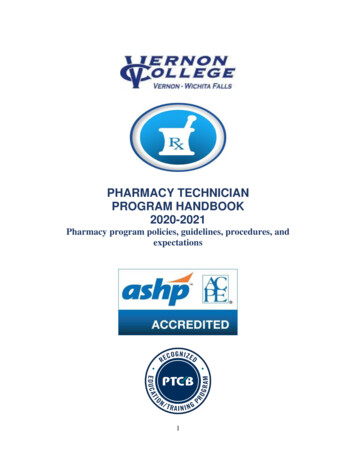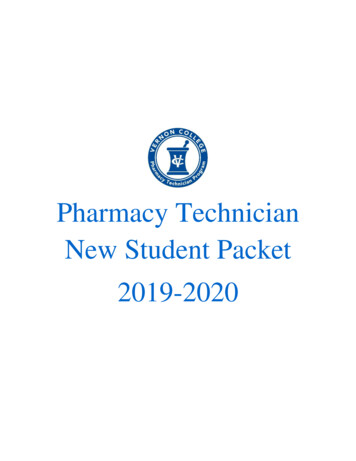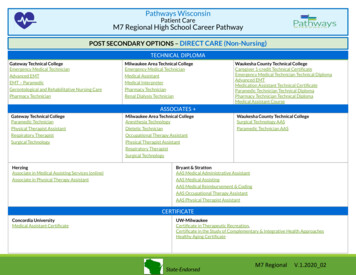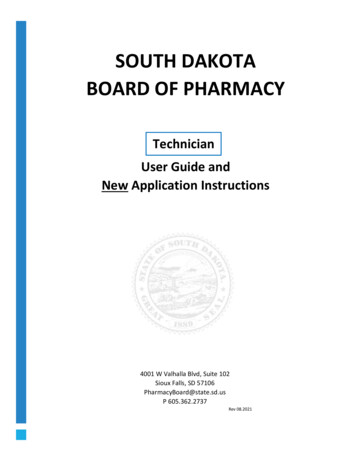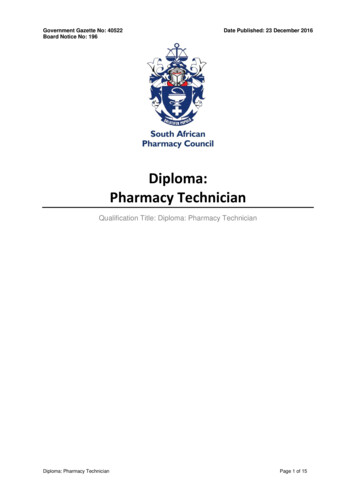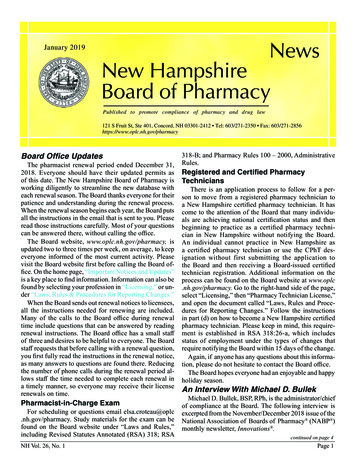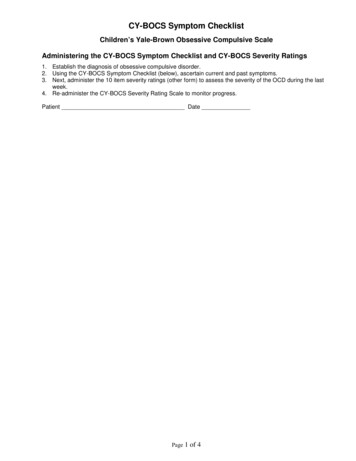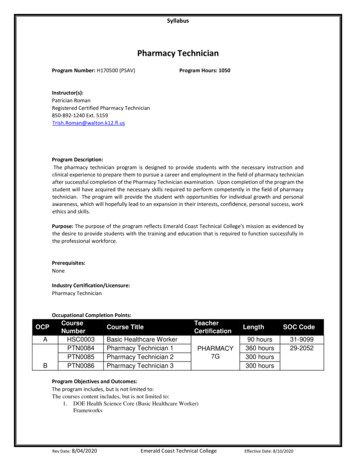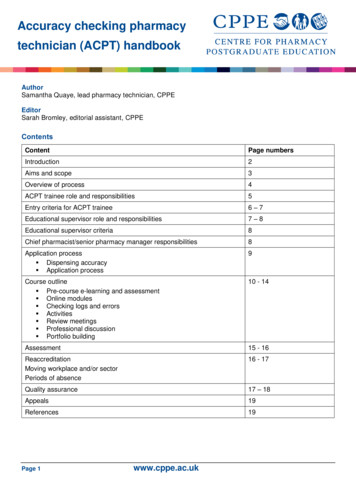
Transcription
Accuracy checking pharmacytechnician (ACPT) handbookAuthorSamantha Quaye, lead pharmacy technician, CPPEEditorSarah Bromley, editorial assistant, CPPEContentsContentPage numbersIntroduction2Aims and scope3Overview of process4ACPT trainee role and responsibilities5Entry criteria for ACPT trainee6–7Educational supervisor role and responsibilities7–8Educational supervisor criteria8Chief pharmacist/senior pharmacy manager responsibilities8Application process Dispensing accuracy Application process9Course outline Pre-course e-learning and assessment Online modules Checking logs and errors Activities Review meetings Professional discussion Portfolio building10 - 14Assessment15 - 16ReaccreditationMoving workplace and/or sectorPeriods of absence16 - 17Quality assurance17 – 18Appeals19References19Page 1www.cppe.ac.uk
Accuracy checking pharmacytechnician (ACPT) handbookIntroductionLearning with CPPEThe Centre for Pharmacy Postgraduate Education (CPPE) offers a wide range of learning opportunities in avariety of formats for pharmacy professionals from all sectors of practice. We are funded by HealthEducation England to offer continuing professional development for all pharmacy technicians andpharmacists providing NHS services in England. For further information about our full learning portfolio, visitour website: www.cppe.ac.ukAccuracy checking pharmacy technicians (ACPTs)Traditionally the role of final accuracy checking of dispensed items was reserved for pharmacists. Over timepharmacists have moved into more clinical, patient-facing positions and pharmacy technicians havecompleted training to enable them to undertake final accuracy checks and become ACPTs.There are many benefits to pharmacy technicians providing the final accuracy check of medicines. Firstly,patients can be assured that a registered healthcare professional, with a specific qualification in accuracychecking, is taking responsibility for them receiving the correct medicine. Other benefits include roledevelopment for all pharmacy team members, optimisation of skill mix and increasing the capacity ofpharmacists to deliver services and undertake more patient-facing roles.Pharmacy technicians who successfully complete this qualification and practise as an ACPT will have anincreased impact on patient care, so it is important that they understand not only risk management andpatient safety aspects of performing final accuracy checks but also the patient-centric philosophyembedded throughout CPPE learning.About the handbookThis handbook provides details of the CPPE Accuracy checking pharmacy technician (ACPT) programme.It takes into account national occupational standards,1 guidance and frameworks; it is intended to act as aguide for all aspects of the programme. There is accompanying e-learning, assessment and practice-basedactivities, as well as external reference sources that will need to be used as part of the development andqualification process.Page 2www.cppe.ac.uk
Accuracy checking pharmacytechnician (ACPT) handbookAims and scopeThe aims of the programme are to: provide pharmacy technicians with the skills and knowledge needed to confirm the accuracy ofdispensed items from prescriptions that have been clinically screened/approved by a pharmacistprior to dispensing develop the pharmacy technician’s professional awareness of pharmacy practice encourage the further development of effective communication skills develop a professional interaction between pharmacy technicians, pharmacists, other healthcareprofessionals, patients and colleagues support appropriate skill-mix within pharmacy departments develop the pharmacy technician’s knowledge and skills in leadership.The scope of the programme is to train and assess pharmacy technicians, working in community pharmacyand secondary care, to perform the final accuracy check of dispensed items on prescriptions that havebeen clinically screened/approved by a pharmacist. The programme has been designed to assureemployers in each sector that pharmacy technicians who successfully complete the set learning andassessments are able to undertake the role and have the appropriate knowledge, skills and behaviours todeliver high-quality, consistent checks of medicines.The programme does not include pre and in-process checks; it does not extend to extemporaneous oraseptic dispensing nor does it include stock orders or emergency supplies. These items should not beincluded as part of the checking logs.Controlled drugs, dosette boxes and unlicensed medicines can be included, providing the dispensarystandard operating procedures (SOPs) allow for this. Orders transcribed from drug charts for namedpatients can also be included provided the ACPT trainee has not had any part in the ordering process andthe order has been clinically screened by a pharmacist.The ACPT programme must have approval from the chief executive of the NHS organisation, or theno.1 governor of Her Majesty’s Prisons, or the superintendent pharmacist of a community pharmacy, beforeit is implemented locally and is dependent on SOPs being in place. It is the responsibility of the chiefpharmacist or senior pharmacy manager to ensure that the chief executive, no.1 governor andsuperintendent pharmacist are notified.Page 3www.cppe.ac.uk
Accuracy checking pharmacytechnician (ACPT) handbookOverview of the processPage 4www.cppe.ac.uk
Accuracy checking pharmacytechnician (ACPT) handbookACPT trainee role and responsibilitiesAn ACPT trainee’s role is to build on their skills and knowledge as a pharmacy technician in order to beable to accurately check dispensed items and provide leadership within the dispensary. Trainees will learnhow to supervise the work of others and contribute to their learning following identification of dispensingerrors. ACPT trainees will also learn how to exercise their professional judgment to make decisions andprioritise work.The final accuracy check is a safety net used to prevent dispensing errors reaching patients so ACPTtrainees need to be aware of their increased impact on patient safety and the extent of their accountabilityduring training and post-qualification.A pharmacy technician who wishes to become an ACPT should be able to demonstrate the qualities andbehaviours required to undertake the ACPT role before applying to the programme. Professionalism,attention to detail and good communication are key to performing successfully as an ACPT.All ACPT trainees must: meet the entry criteria for the CPPE ACPT programme complete all aspects of e-learning, assessment and associated activities follow the GPhC Standards for pharmacy professionals2 ensure that all prescriptions being checked have been clinically screened by a pharmacist have taken no part in the labelling or dispensing of items they are checking record all checking activities using the log forms provided by the educational supervisor notify the educational supervisor each time they make a checking error meet with the educational supervisor following every 250 checked items to discuss and documentprogress complete the programme in 12 months and notify CPPE if they have concerns about their progress submit all documentation in a timely manner to CPPE.Page 5www.cppe.ac.uk
Accuracy checking pharmacytechnician (ACPT) handbookEntry criteria for ACPT traineeThe ACPT trainee must: be registered as a pharmacy technician with the General Pharmaceutical Council (GPhC) successfully complete CPPE’s ACPT introductory e-learning and e-assessment have a minimum of six months dispensing experience within the last 12 months in the dispensarythat they will undertake their ACPT training demonstrate recent ability to dispense accurately in their current workplace, signed off by theireducational supervisorNB: If dispensing logs are used to demonstrate accuracy, there should be no more than threeattempts at any one time in completing the dispensing accuracy logs. If unsuccessful on the thirdattempt then a period of reflection and dispensing re-training should be completed (according tolocal SOPs and risk management strategies) before completing the dispensing accuracy logs again. work in a dispensary that dispenses NHS prescriptions that have been clinically screened/approvedby a pharmacist be familiar with the organisation’s dispensary SOPs have completed the organisation’s induction and in-house mandatory training relevant to role andjob description agree to be contacted by Health Education England/NHS England for the purpose of evaluating thecourse have an educational supervisor appointed who meets CPPE’s ACPT educational supervisorrequirements have support from their senior pharmacy manager.**the senior pharmacy manager is the person who is accountable for budgets, risk assessment and who makesdecisions about service needs, eg, chief pharmacist, superintendent pharmacist or their nominated deputy.Educational supervisor role and responsibilitiesHigh quality and effective educational supervision is an essential component of any practice-based trainingprogramme. The role of the educational supervisor in the ACPT training programme is to support the ACPTtrainee to learn, develop and achieve competency in the skills, knowledge and behaviours required for theresponsibility of the role. It is important that educational supervisors understand what the ACPT programmeentails because they will be accountable for assuring the competence of the pharmacy technician.Therefore, it is imperative that they familiarise themselves with the ACPT programme handbook andcomplete the e-learning and assessment provided before the trainee starts the programme.The added responsibility of taking on the role of final accuracy checking requires pharmacy technicians tobe confident, as well as competent. The educational supervisor should be sufficiently familiar with apharmacy technician and their work in order to satisfy themselves that the pharmacy technician is ready tobecome an ACPT trainee and undertake the role of accuracy checking on successful completion of theprogramme.Educational supervisors must consider the impact on the service of enrolling a pharmacy technician on theACPT programme. SOPs may need to be temporarily adapted to allow for the second and final check of anitem during the training period. ACPT trainees cannot check items that they have labelled or dispensedtherefore staffing levels, or different ways of working, may need to be considered prior to enrolment on theprogramme if this will impact workflow. Additionally, ACPTs can only check clinically screened/approvedPage 6www.cppe.ac.uk
Accuracy checking pharmacytechnician (ACPT) handbookprescriptions, therefore SOPs may need to be changed to ensure that prescriptions are clinically screenedat the start of the dispensing process.The skill mix of the team should be taken into account as other team members’ roles may need to bemodified and workflow may need to be adapted in order to ensure that the ACPT trainee is allocated time tocheck while training. It is also important to note that there may be busy periods when it is not appropriatefor the ACPT trainee to check and the educational supervisor should communicate this to the ACPTtrainee.A key responsibility for educational supervisors is to meet with their ACPT trainee regularly. If they do notwork in the dispensary with them as part of their job role, it is recommended that time is allocated withinwork to provide support. Progress should be monitored on an ongoing basis and CPPE will periodicallycheck this throughout the programme.Following completion of the checking assessments, the ACPT trainee, educational supervisor and seniorpharmacy manager will be informed of the outcome. If the trainee is successful, they may begin checkingfollowing the emailed notification, providing their job description is updated to include the checking role. Acertificate of qualification will be posted following the email notification.The GPhC produces guidance on supporting trainees that sets out expectations of pharmacy professionalsundertaking tutor roles. The guidance is not specific to ACPT courses, however, CPPE expects theprinciples and standards to be followed.All educational supervisors must: ensure they fulfil the entry criteria for an educational supervisor on the CPPE ACPT programme ensure the applicant’s line manager is aware of and supports the application be accountable for ensuring that the ACPT trainee has demonstrated dispensing accuracy ensure the ACPT trainee fulfils the entry criteria for the CPPE ACPT programme make time for training and recognise when it is not appropriate for trainees to complete their logs,eg, during busy periods or for urgent prescriptions offer support, guidance and feedback to the ACPT trainee whilst they undertake practice-basedactivities ensure correct and current recording paperwork is used ensure that local dispensary SOPs are in place and that the trainee is familiar with and worksconsistently within them facilitate the local implementation of the CPPE ACPT programme number and sign each checking log sheet before issuing them to the ACPT trainee monitor progress and meet face to face to discuss checking experience and activities meet with the trainee to complete formal reviews after each 250 items checked and assess theirchecking logs classify any checking errors that the ACPT trainee makes (this can be in conjunction with experts) check that all learning and practice-based activities have been successfully completed in full andcan be evidenced in the ACPT trainee’s portfolio contact CPPE when the trainee has completed the required work and is ready for assessment set up, facilitate, mark and submit the practice-based checking assessment complete a final sign off declaration and submit this to CPPE for certification ensure that the job description includes the checking role if the ACPT will begin checking once theyhave received notification that they have qualified as an ACPT agree to be contacted by Health Education England/NHS England for the purpose of evaluating thecourse.Page 7www.cppe.ac.uk
Accuracy checking pharmacytechnician (ACPT) handbookEducational supervisor criteriaAn educational supervisor for the ACPT training programme must: be registered with the General Pharmaceutical Council be a qualified accuracy checking pharmacy technician or pharmacist have the support of the senior pharmacy manager/chief pharmacist have experience of facilitating staff training be able to meet with the ACPT trainee regularly, approximately every month commit to supporting the ACPT trainee, working in the same dispensary when possible follow GPhC guidance for tutors3 have undertaken the ACPT programme An e-learning programme for ACPT trainees andeducational supervisors in the last two years. successfully complete the CPPE Accuracy checking pharmacy technician programme eassessment (or have successfully completed it) within the last 12 months read, understand and agree to undertake the role and responsibilities of an ACPT educationalsupervisor as set out in the CPPE ACPT handbook.Senior pharmacy manager/chief pharmacist responsibilitiesThe ACPT programme must have approval from the chief executive of the NHS organisation, the no. 1governor of Her Majesty’s Prisons or the superintendent pharmacist, before it is implemented locally and isdependent on standard operating procedures being in place. The senior pharmacy manager/chiefpharmacist is accountable for these requirements being met.Application processDispensing accuracyACPT trainees must have documented evidence of the ability to dispense accurately according to locallyagreed SOPs in order to apply for the CPPE ACPT programme. Educational supervisors will be registeredpharmacy professionals and it will be their responsibility to provide a declaration of dispensing accuracy fortheir ACPT trainee.The method used by the educational supervisor to determine dispensing accuracy must be described in thedeclaration because this may differ between organisations, eg, community pharmacy clinical governanceprocesses may include internal reporting of near misses and errors. If an ACPT trainee has an acceptablerecord then then the educational supervisor can describe this in their declaration.Secondary care traditionally use a 200 item dispensing log to demonstrate competence in dispensing, asset out in the national framework.4 Pharmacy technicians often complete dispensing logs during theirinduction period and/or initial training in the dispensary. Educational supervisors must ensure that if logsare used as evidence of dispensing accuracy they reflect current practice.NB: there should be no more than three attempts at any one time in completing the dispensing accuracylogs. If unsuccessful on the third attempt then a period of reflection and dispensing re-training should becompleted (according to local SOPs and risk management strategies) before undertaking the dispensingaccuracy assessment again.CPPE will provide paperwork to support organisations who wish to use the dispensing log method;however, it is not mandatory for this to be used.Page 8www.cppe.ac.uk
Accuracy checking pharmacytechnician (ACPT) handbookApplication processTo register for this training programme, log on to the ACPT page of the CPPE website:www.cppe.ac.uk/ACPT and complete the following steps in order: check ACPT trainee and educational supervisor entry criteria, and read the associated roles andresponsibilities, to confirm eligibility to enrol complete the application form relevant to sector of work, ie, community pharmacy or secondary care complete the ACPT programme: An e-learning programme for ACPT trainees and educationalsupervisors complete the Accuracy checking pharmacy technician programme (2017) e-assessment access Canvas, the online learning platform for the ACPT programme, using the emailed log ondetails.Page 9www.cppe.ac.uk
Accuracy checking pharmacytechnician (ACPT) handbookCourse outlineThe ACPT programme is a comprehensive learning package designed to develop the skills and knowledgeof pharmacy technicians who work in a dispensary environment. There are seven parts to the learning:Online learning1. Pre-course e-learning and assessment2. Online modulesPractice-based activities3.4.5.6.7.ActivitiesChecking logsReview meetingsMid-point professional discussionPortfolio buildingPre-course e-learning and assessmentAs part of the application process, educational supervisors and ACPT trainees must complete the CPPEACPT programme An e-learning programme for ACPT trainees and educational supervisors. The learningtakes approximately 45 minutes to complete and is designed to provide information about the programme.There is an associated e-assessment which we anticipate will take about 20 minutes to complete and thiswill test understanding of what the CPPE ACPT programme entails.The pass mark for the e-assessment is 80 percent. There is no limit to the number of times that the precourse assessment can be taken, however, multiple failures indicate that those taking the assessment maynot be ready or appropriate to undertake the roles and responsibilities involved in the ACPT programme.Online modulesThere are six online modules that contain the core knowledge learning material that underpins thequalification. This learning is delivered via our online learning platform, Canvas, and is designed for 24-houraccessibility. The six modules are mapped to the Skills for Health national occupational standard foraccuracy checking.We anticipate that the online modules will take a minimum of eight hours to complete. Learning can becompleted in one sitting or in small chunks over a period of time.Practice-based activitiesActivitiesTrainees will be required to undertake activities throughout the ACPT programme and these will be linkedto the online modules. They are designed to build on knowledge gained through e-learning, developleadership skills and enable the trainee to apply learning in the workplace.The checking logACPT trainees must provide evidence of accurately checking a minimum of 1000 items, within one year ofenrolling on the programme. Checking logs must be kept as evidence and must be verified by theeducational supervisor at each review meeting. CPPE may require logs to be submitted at certain pointsprior to certification.Page 10www.cppe.ac.uk
Accuracy checking pharmacytechnician (ACPT) handbookEducational supervisors must review their ACPT trainee’s progress on a regular basis and meet to discusspractice-based activities after completion of each 250 items on the checking log and following any errors.Review meetings need to be recorded on the forms provided in the online learning portfolio, Canvas.Read the following instructions to understand requirements when completing the checking logs. The educational supervisor must consecutively number and sign each log sheet before issuing tothe trainee. The checking log must contain all items checked by the trainee. All items checked must be labelled and dispensed by another person. All items must be clinically screened/approved by a pharmacist before checking. The trainee should check items under normal working conditions. The final check must be carried out by a qualified ACPT or a pharmacist; they should be familiarwith the dispensary SOPs and the ACPT programme. The final checker should record any accuracy checking errors made by the trainee. The log should cover a range of items (eg, solid dose forms, liquids, topical items, etc) and, wherepossible, different prescription types to reflect current practice within the dispensary. Each item checked on the log must be signed by the trainee and by the final checker. The final checker must fill in their GPhC number at the time of signing. Bracketing of items for signature and GPhC number will be accepted for consecutive checks, butthe first and last item must be signed. If this is not done it will result in the log being returned to thetrainee for completion. Logs should not be completed in less than three months. If the trainee identifies a dispensing error, this must be documented fully on the log forms. The itemshould be re-dispensed. If re-dispensed by the original dispenser or another staff member, thetrainee can complete the checking of this item. They should sign only when the item is complete andready for the final check. This is counted as one item. If the trainee checks multiple packs of the same medicine for the same patient, this will count asone item, eg, a prescription for 56 x Furosemide 40 mg tablets where two boxes of Furosemide 40mg tablets are dispensed. However, if multiple packs of the same medicine are required at differentstrengths or in different forms, each will count as an item, eg, if a candidate checks three packs ofwarfarin and each pack is a different strength, this will count as three separate items on the log.Additional guidance to facilitate the processNB: the actions below are not mandatory The trainee may have more than one log sheet in use at a time. Allocate an area for the final checker to file the logs after checking to prevent them being misplaced. If there is more than one ACPT trainee completing checking logs, then logs can be printed ondifferent coloured paper so it is easier to identify who they belong to. Trainees should start by checking prescriptions with one item on them, then gradually increasingthese numbers, before progressing to more complex items, eg, controlled drugs, dosette boxes andmulti-dosage systems (MDS), if appropriate. Secondary care: trainees should start by checking in-patient items without administrationinstructions (acute medical items in HM Prison), before progressing to discharge or out-patientprescriptions (in-possession or court medicine prescriptions for HM Prisons).Page 11www.cppe.ac.uk
Accuracy checking pharmacytechnician (ACPT) handbookErrorsThe ACPT programme recognises that errors can occur within a dispensary and that ACPT trainees are intraining. For this reason a small number of checking errors can be tolerated during the training period. If achecking error is made by the ACPT trainee, ie, they fail to detect a dispensing error, they must stopchecking immediately and report it to their educational supervisor as soon as is practical.The trainee should not continue checking until they have met with their educational supervisor and reflectedon the error. The portfolio must contain records of reflection for each checking error the trainee makesduring the period in which they are enrolled on the programme.Whilst completing the practice-based checking log the following scope for error will apply: 1st attempt - one serious error or three less serious period of reflection and 250 additional items 2nd serious error or a further three less serious failed attempt of the programme.Checking logs are part of the formative assessment process. No ACPT trainee will be allowed more thantwo attempts in total at completing their checking logs.NB: if an ACPT trainee is found to have falsified/deliberately tampered with a checking log in any way,they will be withdrawn from the ACPT programme and will not be permitted to undertake the ACPTprogramme with CPPE.Classification of errorsEach organisation should risk assess errors as part of their near-miss/error reporting processes. Riskassessments of medicine errors are usually based on the potential level of harm to a patient and thelikelihood of that harm occurring.Educational supervisors will determine whether an error is classified as serious or less serious. Thefollowing information acts as guidance to support those decisions however the list is not exhaustive orprescriptive. It is possible that less serious errors could become serious errors in some circumstances,hence the need for educational supervisors to be in a position to assess the associated risk.NB: a less serious error may be up-graded to a serious error but a serious error will not be down-graded.Serious errors includeIncorrect information on the dispensing label: incorrect drug name incorrect drug form incorrect drug strength incorrect quantity incorrect patient’s name incorrect directions missing or inappropriate use of BNF warnings extra labels that have not been removed from returned items (secondary care only) absent labels, ie, trainee has not noticed that the item is missing a label transposed labels.Page 12www.cppe.ac.uk
Accuracy checking pharmacytechnician (ACPT) handbookIncorrect contents: wrong drug wrong drug form wrong drug strength incorrect quantity expired contents.Other: missing or incorrect Patient Information Leaflet missing item sundry, eg, warning card missing medicines prescription not clinically screened/approved by a pharmacist.Less serious errorIncorrect information on the dispensing label: missing or inappropriate additional warnings incorrect spelling incorrect batch number incorrect expiry date incorrect cost code or ward (hospital only).Other: incorrect container or lid missing additional label missing signature unacceptable presentation local procedure not followed incorrect or missing oral measuring device, eg, 5 mL spoon missing owing information missing bag label.Review meetingsEducational supervisors must review the progress of the ACPT trainee at regular intervals during thetraining period and document the details of these meetings. ACPT trainees must be supported followingany checking errors and encouraged to reflect on the error. The trainee must document their reflection ofthe error as part of a review meeting.As a minimum, review meetings must take place after the trainee: checks 250 items checks 500 items checks 750 items makes an error.At the review meeting, the educational supervisor should check that logs have been completed in full, ie,that all details have been recorded, no signatures are missing and that final checkers can be identified.Page 13www.cppe.ac.uk
Accuracy checking pharmacytechnician (ACPT) handbookIf a trainee is not making progress, the educational supervisor should arrange a progress review meeting toidentify what support is needed and discuss an action plan.Review meeting documentation should be submitted via the e-portfolio, Canvas, as soon as possible afterthe meeting. The portfolio must contain a minimum of three review forms.Mid-point professional discussionA discussion will take place between the ACPT trainee and a pharmacy professional from CPPE once 500items have been checked and the trainee has met with their educational supervisor for a progress review.The professional discussion will be an opportunity to reflect on the ACPT training experience and considerthe impact of the ACPT role on patients, including beneficial outcomes. The discussion will focus on theresponsibilities of an accredited checking pharmacy technician and explore any concerns or issues thetrainee may have. Feedback to CPPE about the programme will also be useful at this point.To arrange the professional discussion, the ACPT trainee should enter the date of the 500 item reviewmeeting with their education supervisor into activity series two of the progress tracker. They will receive alink to book a suitable time and date for the discussion in the feedback report in activity series three of theprogress tracker. It is anticipated that the discussion will take approximately 30-45 minutes and will takeplace during normal office hours, 9:00am – 5:30pm, Monday to Friday.According to the proposed assurance framework from GPhC, the peer discussion5 element of revalidationis a formative learning and development activity. The professional discussion with a pharmacy professionalfrom CPPE can be used for this purpose.Portfolio buildingThe educational supervisor will review the ACPT trainee’s portfolio as part of the summative a
pharmacy technician and their work in order to satisfy themselves that the pharmacy technician is ready to become an ACPT trainee and undertake the role of accuracy checking on successful completion of the programme. Educational supervisors must consider the impact on the service of enrolling a
